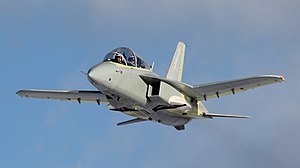The KB SAT SR-10 is a prototype Russian single-engine jet trainer aircraft, fitted with forward-swept wings. It first flew in 2015 and is being offered to the Russian Air Force and for export.
| SR-10 | |
|---|---|

| |
| First prototype of SR-10 during the flight | |
| Role | Training aircraft |
| National origin | Russia |
| Manufacturer | KB SAT, Aviaaggregat, Smolensk SmAZ, KTRV |
| Designer | KB SAT[1] |
| First flight | 25 December 2015 |
| Number built | 1 |
Design and development
editThe Russian design bureau KB SAT[1] (Sovremyenne Aviatsyonne Tekhnologii – Modern Aircraft Technologies) began work on a single-engine jet trainer and sport aircraft, the SR-10, in 2007, displaying a mockup at the MAKS airshow at Zhukovsky in August 2009. The SR-10 is a mid-wing monoplane of all-composite construction, with a wing swept forward at an angle of 10 degrees. The crew of two sit in a tandem cockpit. It is powered by a single turbofan, with an Ivchenko AI-25V AI25TSR (modification of AI25TL) fitted in the prototype, but more modern Russian engines, such as the NPO Saturn AL-55 were proposed for production aircraft.[2]
The SR-10 was offered to meet a 2014 requirement for a basic trainer for the Russian Air force, but was rejected in favour of the Yakovlev Yak-152, a piston-engined trainer. Despite this setback, KB SAT continued to develop the SR-10, proposing it as an intermediate trainer between the Yak-152 and the Yak-130 advanced jet trainer and for export. The first prototype SR-10 made its maiden flight on 25 December 2015.[2]
In July 2017, KB SAT announced that it had developed an unmanned variant of the aircraft named the AR-10 Argument.[3][4]
In September 2018, according to media reports, the Russian government failed to allocate funds to start production of SR-10 for the Russian Air Force and as a result KB SAT suspended all work on the project.[5]
On September 19, 2020, SR-10 took part in the "Russian Aviation Race", held at the Oreshkovo airfield (Kaluga oblast)[6]
Specifications (SR-10)
editData from Russia's New Jet Trainer[2]
General characteristics
- Crew: 2
- Length: 9.59 m (31 ft 6 in)
- Wingspan: 8.40 m (27 ft 7 in)
- Height: 3.55 m (11 ft 8 in)
- Gross weight: 2,400 kg (5,291 lb)
- Max takeoff weight: 2,700 kg (5,952 lb)
- Powerplant: 1 × Ivchenko AI-25V turbofan, 16.87 kN (3,790 lbf) thrust
Performance
- Maximum speed: 900 km/h (560 mph, 490 kn)
- Cruise speed: 520 km/h (320 mph, 280 kn)
- Range: 1,500 km (930 mi, 810 nmi)
- Service ceiling: 6,000 m (20,000 ft)
- g limits: +10/−8
- Rate of climb: 60 m/s (12,000 ft/min)
See also
editAircraft of comparable role, configuration, and era
- Yakovlev Yak-130
- EADS Mako/HEAT
- Guizhou JL-9
- HAL HJT-36 Sitara
- HESA Shafaq
- Hongdu JL-8
- Hongdu L-15
- KAI T-50 Golden Eagle
References
edit- ^ a b "Home". kb-sat.ru.
- ^ a b c Butowski 2016, p. 15.
- ^ "Russia Develops UAV Based on SR-10 Trainer". UAS Vision. 1 August 2017. Archived from the original on 1 August 2017. Retrieved 1 August 2017.
- ^ Novinchkov, Nikolai (26 July 2017). "SAT develops SR-10-based UAV concept". IHS Jane's 360. Archived from the original on 1 August 2017. Retrieved 1 August 2017.
- ^ "Source: Works on New Training Airplane SR-10 Suspended". MIL.TODAY. 14 September 2018. Archived from the original on 16 September 2018. Retrieved 25 November 2018.
- ^ "Jet aircraft race was held near Kaluga (In Russian)". Inter Right. 21 September 2020.
- Butowski, Piotr (February 2016). "Russia's New Jet Trainer". Air International. Vol. 90, no. 2. p. 15. ISSN 0306-5634.
External links
edit- "New Russian forward-swept wing jet trainer has made its first flight. And here’s the video". The Aviationist. 2 January 2016.
- KB-SAT official site (in Russian)